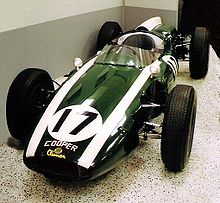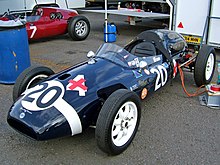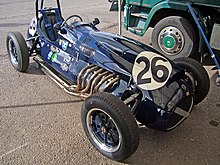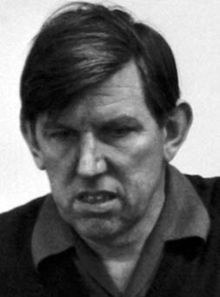Cooper Car Company


Cooper was a British racing car manufacturer that was represented in various motorsport classes with its own works teams in the 1950s and 1960s. Cooper competed in Formula Junior , Formula 3 , the Indianapolis 500 , the Le Mans 24-hour race and Formula 1 . The company also regularly supplied vehicles for customer teams. At times, Cooper was one of the most successful Formula 1 teams. Jack Brabham , Bruce McLaren and Jochen Rindt drove successes on Cooper's works cars. The company is also known for the Mini Cooper .
Company history
Charles Cooper had been running a repair shop for motorcycles and automobiles in the London borough of Surbiton since 1920 . In the 1930s, Cooper casually worked as a mechanic for the British racer Kaye Don , later he managed the Alfa-Romeo pilots Ginger Hamilton .
In 1946, Charles Cooper, his then 23-year-old son John and his school friend Eric Brandon began building their own racing cars “for sheer pleasure”. The first vehicles were intended for the 500 cm³ class, which later became Formula Junior or Formula 3. Cooper's cars had engines from JAP and later Norton and suspension parts from Fiat Topolino . The Coopers initially obtained aluminum sheets, but also accessories such as cables, from a scrap yard in neighboring Kingston , where numerous disused aircraft and military vehicles were parked in the first few years after the war. The power transmission was via a chain to the motorcycle transmission and from there via a chain to the rear axle.
Initially, the cars were driven by Eric Brandon and John Cooper. After proving to be successful, Cooper began to receive more and more orders from other racers. Cooper then began series production, which in 1951 reached a volume of more than one vehicle per week. One of Cooper's earliest customers was Stirling Moss ; his Cooper T5 was his first racing car. Moss, Peter Collins and other drivers celebrated numerous successes with Cooper's Formula 3 cars. These cars were used in local races in England and across the continent until the late 1950s.
After the death of Charles Cooper in the fall of 1964, Ken Tyrrell initially took over the management of the Formula 1 works team. In April 1965, John Cooper sold the racing team to the Chipstead Motor Group, which among other things belonged to the former racing driver Roy Salvadori . John Cooper initially remained technical director, Salvadori became sports director. Mario Tozzi-Condini, a co-owner of the Chipstead Group, made contact with the Italian sports car manufacturer Maserati in the course of 1965 , who agreed to supply Cooper's Formula 1 team exclusively with 3.0-liter vehicles from the 1966 Formula 1 season. Equip twelve-cylinder naturally aspirated engines.
Cooper in Grand Prix racing
Cooper got into Grand Prix racing through Formula 2. In 1952 and 1953 , the automobile world championship was exceptionally not announced according to the Formula 1 regulations, but according to the Formula 2 rules . The reason for this was the fact that not enough competitive Formula 1 vehicles were available. As a result, the world championship was now open to smaller vehicles with a displacement of up to two liters.
Formula 2
1952
In 1952, Charles Cooper and Owen Maddock designed the T20 for Formula 2 , a compact racing car with a front-engined layout and powered by a six-cylinder Bristol engine. The engine was based on a pre-war BMW design and had been in service with the Bristol 400 street sports car and its successors since 1946 . For use in motorsport, the output has been increased to around 130 hp. The power was about 30 hp below that of the contemporary Ferrari. However, the T20 was around 50 kg lighter than the Italian racing cars. The T20 and its successor T23 went down in motorsport history as the “Cooper-Bristol” Mark I and Mark II.
In 1952, Cooper did not compete with a works team in the automobile world championship, but sold his vehicles to independent racing teams. The preferred team in 1952 was the Ecurie Richmond , a private racing team led by Jimmy Richmond, which started two T20s for Eric Brandon and Alan Brown in five championship races . Richmond's team had nominal factory status, but actually operated independently and received little technical support from Charles and John Cooper. Brandon was a link between Cooper and Richmond, however. Another T20 went to Bob Chase, who passed the car on to Leslie Hawthorn, father of young British racing driver Mike Hawthorn . Reg Parnell and David Murray also contested individual races in the T20 .
The Cooper T20-Bristol first appeared in April 1952 at the Lavant Cup on the Goodwood Circuit . Hawthorn, Brown and Brandon took first, second and third place. However, the race did not have championship status. The first world championship race of the year was the Swiss Grand Prix in Bremgarten . Brown crossed the finish line in fifth, scoring the first world championship points for a Cooper car. Hawthorn, who drove for his own team, finished third in the British Grand Prix . In the Netherlands he finished third behind the factory Ferraris , and in Italy he drove in the slipstream of Piero Taruffi's Ferrari until his technical failure . Hawthorn's work in the Cooper convinced Enzo Ferrari of the young Brit's potential, so he signed Hawthorn as a works driver for the coming season.
1953
In the 1953 season, Cooper participated with a works team in individual races of the drivers' world championship. This year, Cooper could not build on the successes of the previous season. The plant manufactured different chassis that differed from one another in numerous details and were equipped with different engines. Overall, Cooper missed a consistent line.
Cooper's new model was the T23 ("Cooper-Bristol Mk. II"), a revised version of the T20 with a lighter frame and larger brakes. They were mostly powered by the well-known Bristol engines; Instead, a single piece received a four-cylinder engine from Alta .
At the Argentine Grand Prix , Alan Brown, John Barber and Adolfo Schwelm-Cruz were three drivers for the Cooper works team; Brown and Barber finished last in eighth and ninth place. Cooper skipped the following world championship runs. The works team only reappeared at the French Grand Prix . The driver was now Stirling Moss , who drove a T23 with an Alta engine. Moss qualified for 13th place on the grid. He retired early in the race due to a clutch defect. Moss achieved the best result at the German Grand Prix , which he finished sixth.
In addition to Moss, numerous private drivers took to the starting line in Cooper vehicles over the course of the year, including Ken Wharton , Bob Gerard and Tony Crook , who later became the sole owner of Bristol Cars. Cooper's cars were also used in numerous races without world championship status. The best overall race result for Cooper was achieved by Rodney Nuckey at the Gran Premio di Siracusa in Sicily: Here he finished third behind Emmanuel de Graffenried and Louis Chiron . Two more Cooper under Eric Brandon and Peter Whitehead followed in fourth and fifth.
At the end of 1953, Cooper ended factory use of the T23. However, numerous private drivers used the cars for Formula 2 races until 1956. Individual models were also used in Formula 1 races, but did not achieve any success in the larger and more powerful Formula 1 cars. Jack Brabham drove a T23 in numerous Australian races.
1957 to 1960
In the years from 1954 onwards, Formula 2 no longer had the same significance as in 1952 and 1953. From 1954 onwards, the automobile world championship was held after Formula 1 again. In 1954 there were only seven races for Formula 2 vehicles in Europe, four of which took place in the GDR with almost exclusively German participation. In 1955 there was only one Formula 2 race, the Lavant Cup in Goodwood. In 1956, Formula 2 began to be re-established. In that year, six Formula 2 races were held again, all of which took place in Great Britain, and in 1957 the series again received international attention. It stayed on the racing calendar until 1960.
With the resurgence of Formula 2, Cooper revolutionized formula racing: In 1956, Cooper introduced the T41 , one of the first racing cars of the post-war period to be equipped with a mid- engine. The conception went back to Owen Maddock and Jack Brabham and was based on the T39 sports car presented in 1955 . The T41 and its successors T43 and T45 were primarily intended for Formula 2; Both the T43 and the T45, however, were regularly used in a slightly different form - including with enlarged tanks - in Formula 1. They formed the conceptual basis for pure Formula 1 vehicles that Cooper produced from 1959.
From 1957 Cooper dominated Formula 2 for a long time with its mid-engine racing cars. In 1956, the Cooper works team competed with Roy Salvadori and Jack Brabham. Salvadori won four out of six races of the year with his T41. In 1957 the dominance was even more overwhelming: Cooper pilots won 13 of 16 races; only one victory each went to a Ferrari, Lotus and BRM driver. The situation was similar in 1958: In 15 out of 20 races, the victory went to drivers who had competed with a Cooper T43 or a T45. In the following year, Cooper drivers won 23 of 25 Formula 2 races. In 1960, however, Cooper developed serious competition in the form of the Lotus 18 , which took over the design features of the Cooper T41 / 43/45 and had an innovative plastic body. Porsche was also competitive with the 718 , which the Rob Walker team also used in addition to the works team, which appeared sporadically .
From 1964
From 1961 to 1964 there were no separate races for Formula 2 in view of the fact that Formula 1 with the displacement limitation of 1.5 liters actually corresponded to Formula 2; their role was taken by Formula Junior or (from 1964) Formula 3 . Cooper produced numerous cars for this junior class that were used by various teams. The plant supported the Tyrrell Racing Organization , which celebrated numerous successes in the early 1960s with pilots such as John Love , Tony Maggs and Denis Hulme .
When Formula 2 was revived in 1964, Ken Tyrrell's racing team initially took on the role of the quasi-works team in this class. The Cooper cars of that era were unsuccessful, however; Brabham and Lotus now dominated the series. Tony Hegbourne won the 1964 Berlin Grand Prix at AVUS in a Cooper T71 for Normand Racing ; that was the only victory that was achieved in three years with a Cooper vehicle in the Formula 2 car. In 1966, Tyrrell switched to a Matra chassis, and in the following year there were almost no more Cooper in a Formula 2 race.
formula 1
Sports cars and Formula 2 cars with a mid-engine followed from 1955, a sensation at the time. The engine came from Coventry Climax . The great success in Formula 1 came in 1958 when Stirling Moss won the Argentine GP and Maurice Trintignant won the Monaco GP. These victories made it clear that front-engined vehicles were a thing of the past in Formula 1, and within three years all teams had switched to mid-engined vehicles. 1959 was Jack Brabham world champion in Formula 1, on Cooper-Climax, the first on a mid-engine car, and he was able in 1960 to defend his title in an impressive way.
After Jack Brabham left the team to build his own racing car, Bruce McLaren became the number one driver. In 1962 he won in Monaco and was third in the World Cup. In 1963 and 1964, Cooper finished the constructors' championship in fifth place. In 1965, Cooper was the springboard to a great career for Jochen Rindt , as well as for Ron Dennis , who was Rindt's mechanic at the time. The traditional Italian brand Maserati was secured as engine supplier for 1966 , and the team experienced a final boom. John Surtees , dismissed from Ferrari, was able to win the Mexican GP. In 1967 Pedro Rodríguez surprisingly won the South African GP; it was the last victory for the successful team. Otherwise the year went worse than expected, and the cooperation with BRM as an engine supplier in 1968 did not bring the desired success, and the team withdrew from motorsport. Vic Elford's start at the 1969 Monaco GP was the last time a Cooper competed in Formula 1.
Mini Cooper
Cooper is not only known from Formula 1: the Mini Cooper , very successful as a rally vehicle in the 1960s, developed into a cult vehicle.
Web links
Individual evidence
- ↑ a b c Ménard: La Grande encyclopédie de la Formule 1, p. 217.
- ↑ David Hodges: Racing Cars from AZ after 1945, p. 59.
- ↑ a b Mike Lawrence: Grand Prix Cars 1945-64, p. 77.
- ↑ a b Hodges: Racing cars from AZ after 1945, p. 273.
- ↑ Cimarosti: The Century of Racing, p. 132.
- ↑ Cimarosti: The Century of Racing, p. 139.
- ↑ Mike Lawrence: Grand Prix Cars 1945-65, p. 78.
- ↑ a b c Hodges: Racing cars from AZ after 1945, p. 62.
- ^ Ménard: La Grande encyclopédie de la Formule 1, p. 218.
- ^ Hodges: Racing cars from AZ after 1945. P. 144.






